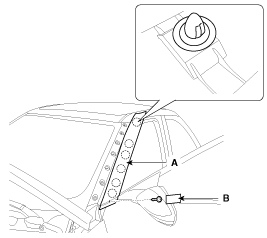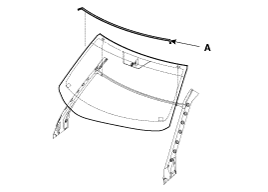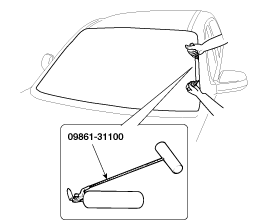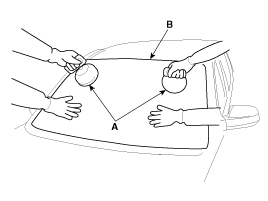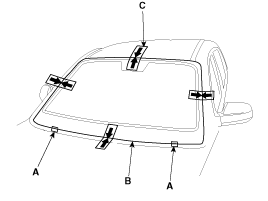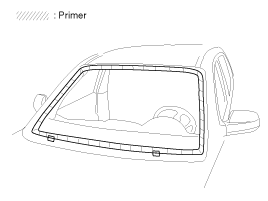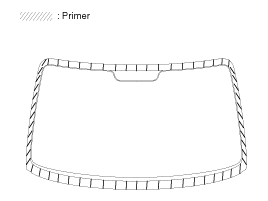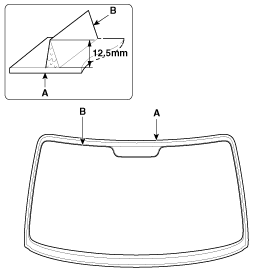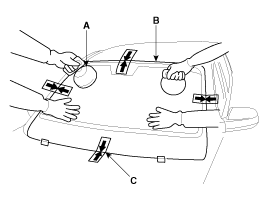 Hyundai Veloster: Windshield Glass. Repair procedures
Hyundai Veloster 2011-2017 Service Manual / Body (Interior and Exterior) / Interior / Windshield Glass. Repair procedures
Hyundai Veloster: Windshield Glass. Repair procedures
Hyundai Veloster 2011-2017 Service Manual / Body (Interior and Exterior) / Interior / Windshield Glass. Repair procedures
Hyundai Veloster 2011-2017 Service Manual / Body (Interior and Exterior) / Interior / Windshield Glass. Repair procedures
Replacement
| Removal |
|
| 1. |
Remove the following items.
|
| 2. |
To remove the A pillar garnish (A), loosen the mounting
screw after removing the cap (B).
|
| 3. |
Using a screwdriver or remover, remove the windshield
glass upper molding (A).
|
| 4. |
Cut out the sealant using the sealant cutting tool
(09861-31100).
|
| 5. |
Remove the windshield glass (B) carefully using the
glass holder (A).
|
| Installation |
| 1. |
With a knife, scrape the old adhesive smooth to a
thickness of about 2mm (0.08 in.) on the bonding surface around the
entire windshield opening flange:
|
| 2. |
Clean the bonding surface with a sponge dampened
in alcohol. After cleaning, keep oil, grease and water from getting
on the clean surface.
|
| 3. |
Install the spacer (A) install the windshield glass
(B) temporarily with marking sure to position them on the center, and
then place the alignment mark (C).
|
| 4. |
With a sponge, apply a light coat of body primer
to the original adhesive remaining around the windshield opening flange.
Let the body primer dry for at least 10 minutes.
|
| 5. |
Apply a light coat of glass primer to the outside
of the fasteners.
|
| 6. |
Pack adhesive into the cartridge without air pockets
to ensure continuous delivery. Put the cartridge in a caulking gun,
and run a bead of adhesive (B) around the edge of the windshield glass
(A) between the fastener and molding as shown. Apply the adhesive within
30 minutes after applying the glass primer.
Make a slightly thicker bead at each corner.
|
| 7. |
Use suction cups (A) to hold the windshield glass
(B) over the opening, align it with the alignment marks (C) made in
step 15, and set it down on the adhesive. Lightly push on the windshield
until its edges are fully seated on the adhesive all the way around.
Do not open or close the doors until the adhesive is dry.
|
| 8. |
Install the A pillar garnish (A) and then install
the A pillar garnish mounting screw, cap (B).
|
| 9. |
Scrape or wipe the excess adhesive off with a putty
knife or towel. To remove adhesive from a painted surface or the windshield,
wipe with a soft shop towel dampened with alcohol.
|
| 10. |
Let the adhesive dry for at least one hour, then
spray water over the windshield and check for leaks. Make leaking areas,
and let the windshield dry, then seal with sealant:
|
| 11. |
Reinstall all remaining removed parts. Install the
rearview mirror after the adhesive has dried thoroughly. Advise the
customer not to do the following things for two the three days:
|
| 12. |
Installation the following items.
|
 Windshield Glass. Components and
Components Location
Windshield Glass. Components and
Components Location
Components
1. Windshield glass
2. Windshield glass upper molding
...
 Tailgate Glass. Components and Components
Location
Tailgate Glass. Components and Components
Location
Components
1. Tail gate glass
...
See also:
Intake Air Temperature Sensor (IATS). Schematic Diagrams
Circuit Diagram
...
Instrument panel fuse replacement
1. Turn the ignition switch and all other switches off. 2. Open the fuse panel
cover.
3. Pull the suspected fuse straight out. Use the removal tool provided in the
engine compartment fuse pan ...
Manual heating and air conditioning
The heating and cooling system can be controlled manually by pressing buttons
or turning knob(s) other than the AUTO button. In this case, the system works sequentially
according to the order of b ...
Categories
- Hyundai Veloster Manuals Home
- Hyundai Veloster 2010-2017 Owner's Manual
- Hyundai Veloster 2010-2017 Service Manual
© 2011-2025 Copyright www.hvmanual.com

